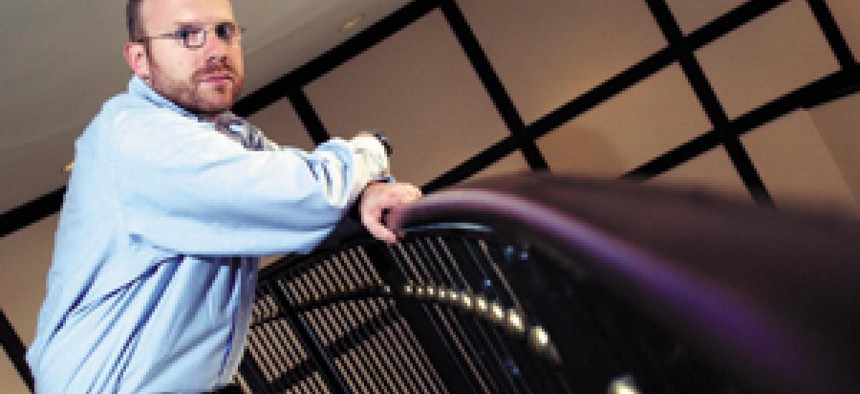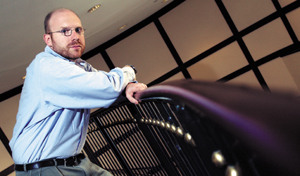Early returns

The machines aren't effective if you don't know how to use them -- that's the one big lesson officials learned about e-voting systems in the Nov. 2 election.
The machines aren't effective if you don't know how to use them -- that's the one big lesson officials learned about e-voting systems in the Nov. 2 election. In some places, poll workers were unaware they needed to boot up the e-voting machines before voting began. In others places, election officials forgot to plug in the machines, which caused them to shut down when their batteries ran out. In a few cases, poll workers inadvertently activated the procedures for closing voting rather than opening it on the machines. Because the carefully monitored machines cannot be restarted once the closing process starts, new machines had to be sent to the field.Despite such problems, election officials reported no widespread malfunctions with e-voting systems. The number of voters who cast their votes electronically more than doubled since the 2000 presidential election. Roughly 50 million votes in the 2004 presidential election were cast on e-voting machines vs. 35 million in 2002 and 20 million in 2000, according to Election Data Services Inc., a Washington political consulting firm specializing in election administration and analysis. The estimates are based on studies of voting equipment used by election jurisdictions across the nation. "Everything went smoothly, with a couple of exceptions," said Dan Seligson, editor of Electionline.org, a nonpartisan Web site that provides information about election reform and is sponsored by the Election Reform Information Project of Richmond, Va.He said the e-voting problems fell into two broad categories: machines that crashed and had to be taken offline, and selections on review screens at the end of electronic ballots showing results that conflicted with the actual vote cast.In Georgia, one of only four states that deployed statewide e-voting in time for this year's election, 3.2 million voters cast their votes on 25,000 AccuVote-TS machines manufactured by McKinney, Texas-based Diebold Election Systems Inc., according to Chris Riggall, spokesman for the Georgia Secretary of State, which establishes election procedures for the state."On election day, poll workers and elections officials can make mistakes. There were issues that arose," Riggall said. "But compared to the bad old days, it was much smoother than four years ago." Skeptics remain unconvinced. Since the controversial 2000 presidential election, more than two dozen organizations have sprung up to monitor irregularities associated with e-voting. TrueVoteMD, a Takoma Park, Md., group, had about 60 volunteers fan out across Maryland precincts to watch and record problems on Diebold's touch-screen machines. The group noted about 400 incidents of voting irregularity in Maryland, said Co-Director Linda Schade."There were a lot of machine crashes and errors that disenfranchised voters," she said. "We need to address those things in a systematic way, so that voters aren't disenfranchised in the future."With this kind of opposition, it is clear that more will have to be done before the public is thoroughly convinced of the merits of e-voting and assured of its security. "The people who didn't trust electronic voting didn't come out of [Nov. 2] thinking that they suddenly trust it," Seligson said. TRAINING DAZEBoth elections officials and voters see significant advantages to e-voting, said David Bear, Diebold's spokesman. Elections officials like the machines because they comply with the Americans with Disability Act, and because they can handle multiple ballots easily. Voters like the machines because they are easy to use once voters become accustomed to them. "We are seeing 90 percent acceptance of [e-voting] by voters," Bear said.Diebold has between 45,000 and 50,000 touch-screen machines, a form of direct recording electronic, or DRE, systems deployed in 14 states. There are statewide implementations in Georgia and Maryland, Bear said. The benefits of having trained poll workers to operate e-voting equipment before the presidential election were clearly evident in some states and conspicuously absent in others, election experts said. One of the biggest success stories is Nevada, where state officials mandated that each poll worker undergo three days of training on the new equipment before the election, said Amy Santenello, senior research analyst for government studies with the research and consulting firm Meta Group Inc., Stamford, Conn. But Nevada was the exception, she said. Unlike many other states, it enjoys a large pool of retired workers who can afford the time to attend training. Without better education and training, both poll workers and elections officials are often hard-pressed to make the quick decisions necessary to make voting go smoothly."This is a very different environment than a Wal-Mart checkout line where you have full-time workers," Georgia's Riggall said. "You've got to make sure you have [an e-voting] system that poll workers can operate."Punch cards, which the Help America Vote Act of 2002 provides funds to replace, were used in 69 of Ohio's 88 counties in the 2004 presidential election. Ohio Secretary of State J. Kenneth Blackwell approved three vendors to sell electronic systems to counties last year, but later put the brakes on new purchases until lingering security issues were resolved. Those companies are Diebold, Elections Systems and Software Inc., Omaha, Neb., and Hart Intercivic Inc., Austin, Texas. "It was a good thing [Ohio] didn't deploy statewide for this election in retrospect, because it was a swing state, and it would have added more stress for the jurisdictions," said Michelle Shafer, Hart Intercivic's spokeswoman. The company has verbal commitments from 10 counties to buy its machines. Hart Intercivic deployed about 25,000 machines in nine states, including California and Texas, during the presidential election, she said. The company teamed with systems integrator Maximus Inc. of Reston, Va., for one of its largest deployments in Orange County, Calif., and also will team with Maximus in Ohio. BETTER REGISTRATIONExperts said the Nov. 2 election also showed that procedures around provisional balloting need to be tightened. The Help America Vote Act introduced the provisional ballot to national voting. Under the new rules for these ballots, voters who are not registered in the precinct where they show up to vote on election day are allowed to cast paper ballots. After it's been determined the voters are registered somewhere, these provisional ballots are counted in the final election results. All states are to have centralized voter registration systems by 2006, which may reduce the provisional ballots cast by verifying that a voter is registered, election experts said. Only 15 states had deployed statewide registration systems in time for the 2004 presidential election, they said. Several systems integrators, including Accenture Ltd.; Covansys Corp., Farmington Hills, Mich., and Unisys Corp., are pursuing contracts for centralized voter registration systems. Last month, Accenture won a four-year, $20 million contract from Wisconsin to provide software development, maintenance and support for a centralized voter registration system, state officials said.Critics of e-voting systems contend that the systems are vulnerable to manipulation and unintentionally inaccurate voting. Computer scientists from Johns Hopkins University in Baltimore singled out Diebold, claiming its system was fraught with security vulnerabilities. Similar studies from academics at other universities soon followed. However, Diebold's Bear said the computer scientists made inaccurate assumptions about the company's software code after someone posted part of it on the Internet. "There was more focus on us [than the other companies] because they had access to our code," he said. "There was an incorrect belief that they could hack into the system." To the critics, the answer was to require that e-voting systems include a paper audit trail that the voters could review after casting ballots. This would alleviate anxiety over whether the vote was cast and recorded correctly. California and Ohio have laws requiring a paper audit trail with any e-voting system by 2006, according to Electionline.org.TrueVoteMD plans to file a lawsuit next year to force Maryland to provide a voter-verified paper audit trail with its e-voting system, said Robert Ferraro, TrueVoteMD's other co-director. The dispute over e-voting security partially obscured the advantages of e-voting, elections experts said. E-voting lets voters with disabilities cast independent and secret ballots; provides multilingual ballots for non-English speaking voters; and more easily manages multiple ballots than do paper-based systems, they said.Seligson also said election officials are becoming more adept at using e-voting machines. For example, some Florida poll workers using e-voting systems for the first time in 2002 forgot to boot up their machines before the polls opened in some counties. They didn't make the same mistake in the 2004 elections, he said. "There probably won't be another circumstance where they make the boot-up mistake and don't get the machines up and running in time," Seligson said. "Other people's errors are now contributing to the knowledge base about e-voting." Staff Writer William Welsh can be reached at wwelsh@postnewsweektech.com. XXXSPLITXXX-Increasing numbers of states are leaning toward requiring a voter-verified paper audit trail for their e-voting systems in time for the next presidential election, according to election experts and industry officials.Nevada was the only state to use the controversial voter-verified paper audit trail in the 2004 presidential election. The state used touch-screen machines manufactured by Sequoia Voting Systems Inc., Oakland, Calif. Sequoia is the only company that provides a paper record that voters can review after casting their ballots to verify their selections. Other companies, such as Diebold Election Systems Inc., McKinney, Texas, and Hart Intercivic Inc., Austin, Texas, are prepared to retrofit their machines with paper printouts if their customers request it, company officials said. The desire to have a voter-verified paper audit trail has been growing since computer scientists at John Hopkins University in Baltimore alleged last year that the e-voting system Diebold sold to Maryland failed to meet minimal security standards. The company disputed these claims, but the accusations fueled efforts nationwide to require the voter-verified paper audit trail for new e-voting systems.In theory, election officials would use the receipts to double check electronic totals. Voters could use the receipts to review their final ballots, but they would not be allowed to keep them. David Bear, a Diebold spokesman, said that while the company's e-voting systems don't provide a paper audit trail for voters, they do provide one for election officials to review and verify. The company's touch-screen machines have a thermal printer that works much like a cash register in that it keeps a running tally that election officials can audit, he said. If Diebold's customers request a voter-verified paper audit trail, the company will provide one, he said."There is this misperception that vendors don't want to provide a paper receipt, and that is that is the furthest thing from the truth," he said. "We are going to provide either what our customers want or regulators ask for."In September, California Gov. Arnold Schwarzenegger (R) signed a bill requiring that by January 2006, all e-voting systems used in the state produce a voter-verified paper audit trail. Ohio also will require a paper audit trail for e-voting systems by that year, elections experts said. Georgia would consider retrofitting its Diebold e-voting systems with a voter-verified paper audit trail if federal standards were issued for it, said Chris Riggall, a spokesman for the Georgia Secretary of State. Such standards should state the purpose of the paper audit trail and whether the electronic or paper record serves as the official ballot, he said. The Help America Vote Act of 2002 requires that by 2006, each polling site have at least one e-voting machine that complies with the Americans with Disabilities Act, said Dan Seligson, editor of Electionline.org, a nonpartisan Web site that offers election reform information. Officials must decide whether the e-voting systems they choose will have paper audit trails, he said.


"The people who didn't trust electronic voting didn't come out of [Nov. 2] thinking that they suddenly trust it." ? Dan Seligson, editor of Electionline.org
Rick Steele
NEXT STORY: DHS to upgrade enforcement systems

